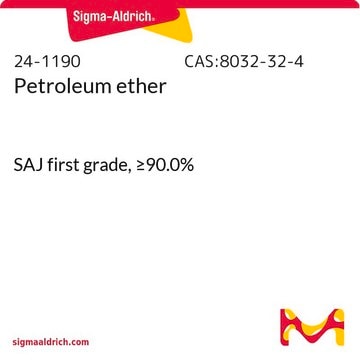13-0800
Hexane
≥95.0%, SAJ first grade
Synonym(s):
n-Hexane
Select a Size
Select a Size
About This Item
5.2 psi ( 37.7 °C)
~132 mmHg ( 20 °C)
Recommended Products
Product Name
Hexane, SAJ first grade, ≥95.0%
grade
SAJ first grade
vapor density
~3 (vs air)
vapor pressure
256 mmHg ( 37.7 °C)
5.2 psi ( 37.7 °C)
~132 mmHg ( 20 °C)
Assay
≥95.0%
form
liquid
autoignition temp.
453 °F
expl. lim.
7.7 %
availability
available only in Japan
dilution
(for analytical testing)
refractive index
n20/D 1.375 (lit.)
pH
7
bp
69 °C (lit.)
mp
−95 °C (lit.)
density
0.659 g/mL at 25 °C (lit.)
SMILES string
CCCCCC
InChI
1S/C6H14/c1-3-5-6-4-2/h3-6H2,1-2H3
InChI key
VLKZOEOYAKHREP-UHFFFAOYSA-N
Looking for similar products? Visit Product Comparison Guide
Related Categories
Signal Word
Danger
Hazard Statements
Precautionary Statements
Hazard Classifications
Aquatic Chronic 2 - Asp. Tox. 1 - Flam. Liq. 2 - Repr. 2 - Skin Irrit. 2 - STOT RE 2 Inhalation - STOT SE 3
Target Organs
Central nervous system, Nervous system
Storage Class Code
3 - Flammable liquids
WGK
WGK 3
Flash Point(F)
-7.6 °F
Flash Point(C)
-22 °C
Regulatory Listings
Regulatory Listings are mainly provided for chemical products. Only limited information can be provided here for non-chemical products. No entry means none of the components are listed. It is the user’s obligation to ensure the safe and legal use of the product.
PRTR
Class I Designated Chemical Substances
FSL
Group 4: Flammable liquids
Type 1 petroleums
Hazardous rank II
Water insoluble liquid
ISHL Indicated Name
Substances Subject to be Indicated Names
ISHL Notified Names
Substances Subject to be Notified Names
JAN Code
13-0800-8-12KG-J:
13-0800-3-3L-J:
13-0800-5-500ML-J:
Choose from one of the most recent versions:
Already Own This Product?
Find documentation for the products that you have recently purchased in the Document Library.
Customers Also Viewed
Active Filters
Our team of scientists has experience in all areas of research including Life Science, Material Science, Chemical Synthesis, Chromatography, Analytical and many others.
Contact Technical Service












